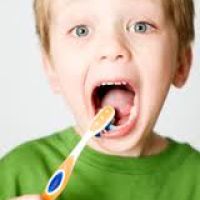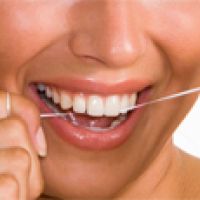Teeth 101
Here are some tips for you and your family that will help keep your smile bright!



Keeping Your Children's Teeth Healthy
1. Remember, a child's dental care begins before birth.
A child's teeth form between the third and sixth month of pregnancy. An expectant mother must practice good health habits to ensure proper development of her unborn child's teeth. This means consuming plenty of calcium-rich foods such as leafy greens, fortified cereals and dairy or soy products.
2. Just because you can't see a babby's teeth, doesn't mean they aren't there.
At birth, your baby has 20 primary teeth, some of which are almost completely formed in the jaw. The first four teeth will usually erupt when the baby is between 6 months and 1 year, but that doesn't mean you can't do anything in the meantime. Simply wiping a baby's gums with a clean gauze pad after feeding will remove harmful plaque and bacteria.
3. Take your child to the dentist by his/her first birthday.
A dentist will check your 1-year-old for tooth decay, as well as identify fluoride needs and address any potentially dangerous habits such as thumb sucking.
4. Don't usetoothpaste for children under 2.
As soon as the first teeth appear, brush them with a little bit of water. After children have reached the age of 2, toothpaste can be introduced in pea-sized amounts.
5. Teach your children the proper brushing technique.
Most children will be able to brush their own teeth by age 6 or 7. Select for them a brush that has soft, rounded bristles and teach them to use only a pea-sized amount of toothpaste. Show them how to use circular brush strokes to reach all surfaces of teeth, and make sure they spit out the toothpaste and rinse with water after brushing to avoid swallowing any toothpaste.
6. Don't forget the floss!
As soon as any two teeth touch, make sure that you use floss to clean between your child's teeth. This is the only way to avoid decay in places where a toothbrush can't reach.
7. Make trips to the dentist fun for your child.
It is important for your child to have a good attitude toward dental visits. Be positive and remind your child that the dentist is a friendly doctor who is helping to take care of his or her teeth. Set a good example yourself by brushing and flossing twice a day and visiting the dentist regularly.
8. Take an active role in your child's oral health.
You should always inform the dentist as to the status of your child's health. Tell the dentist if your child is ill, what medications your child may be taking and if your child has any known drug allergies. If you don't understand a dentist's recommendations for the treatment of your child, ask for a more detailed explanation. Ask if there are other treatments available for this problem and, if so, how these other options compare cost wise. Then ask which of these methods would be most effective in treating the problem.

Brushing for Oral Health
1. Brush your teeth at least twice a day.
When you brush, don't rush. Take enough time to do a thorough job.
2. Use the proper equipment.
Use a fluoride toothpaste and a soft-bristled toothbrush. Consider using an electric or battery-operated toothbrush, especially if you have arthritis or other problems that make it difficult to brush effectively.
3. Practice good technique.
Hold your toothbrush at a slight angle against your teeth and brush with short back-and-forth motions. Remember to brush the inside and chewing surfaces of your teeth, as well as your tongue. Avoid vigorous or harsh scrubbing, which can irritate your gums.
4. Know when to replace your toothbrush.
Invest in a new toothbrush or a replacement head for your electric toothbrush every three to four months — or sooner if the bristles become frayed.

Flossing for Oral Health
You can't reach the tight spaces between your teeth or under your gum line with a toothbrush. Consider these flossing basics from the American Dental Association. That's why daily flossing is important. When you floss.
1. Don't skimp
2. Take it one tooth at a time.
Use your thumbs and forefingers to gently pull the floss from the gumline to the top of the tooth to scrape off plaque. Rub the floss against all sides of the tooth. Unwind to fresh floss as you progress to the next tooth.
3. Keep it up.
If you have trouble getting floss through your teeth, try the waxed variety. If it's hard to manipulate the floss, use a floss holder or an interdental cleaner — such as a dental pick or stick designed to clean between the teeth.
